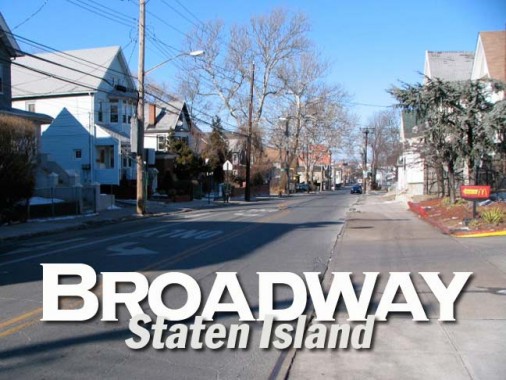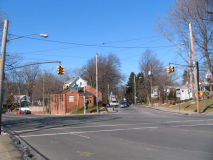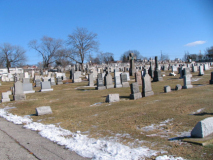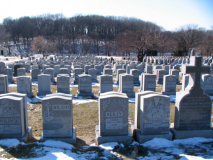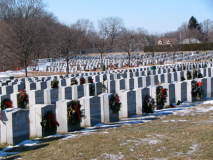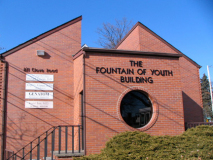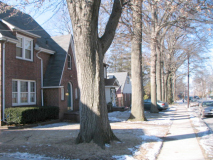Staten Island’s surviving Broadway is one of the main north-south streets of West New Brighton, running from Clove Road at St. Peter’s Cemetery generally north to Richmond Terrace. I say “surviving” because Staten Island has had a number of Broadways over the years, as this list by historian Steve Morse attests: there have also been Broadways in Willowbrook, Huguenot Park, Port Richmond, Rosebank and Tottenville. Hundreds of Staten Island streets were renamed between about 1910 and 1930 — likely to avoid duplication after the borough was consolidated into NYC in 1898. West New Brighton’s Broadway is the sole survivor of Staten Island’s Broadways.
West New Brighton, or West Brighton, is in north central Staten Island in the area generally northeast of Clove Lakes Park and just northwest of Silver Lake Park. It’s named for its position west of New Brighton along Staten Island’s north shore which was, in turn, named for Brighton, a seaside resort town in Britain. It was first settled in the mid-19th Century and was originally largely populated by Irish and Italian immigrants, many of whom worked along the dry docks and ship repair facilities along Richmond Terrace and the Kill Van Kull.
GOOGLE MAP: West New Brighton
Broadway (right foreground) diverges from Clove Road (left). Clove Road, one of Staten Island’s main NE-SW routes, runs from West New Brighton SE to Grasmere. It is not named for any clover plants in the region, but rather for its position, “cleaving” the two high elevations of Grymes and Emerson Hills through a steep valley. In 1964, NYC took advantage of this valley and ran the Staten Island Expressway through it, connecting the Goethals and Verrazano-Narrows Bridges.
St. Peter’s Cemetery is the oldest Roman Catholic cemetery in Staten Island, instituted in 1848, straddling either side of Clove Roadnorth of Clove Lakes Park. Whenever I went past it, I had a feeling it was a military cemetery, such as National Cemetery in Cypress Hills, Brooklyn, because of the uniformity in the heights of the memorial stones, but it isn’t; the uniformity probably is because most of the stones were done by a single local stonecutter.
I had not walked Broadway’s full length before this survey, but I was somewhat familiar with it: the S53 bus, which runs from Bay Ridge to Port Richmond over the Verrazano-Narrows Bridge, travels its entire length. I took that bus hundreds of times between 1964 and 1993, when I moved to Fab Flushing. Unlike the Broadways of Brooklyn, the Bronx, Manhattan and Queens, Staten Island’s Broadway, of course, has no subway or elevated train along its length.
Rather ironic to have the Fountain of Youth Building (in the V formed by Clove and Broadway — medical and pharmaceutical offices) across from a cemetery…
The stretch of Broadway just north of Clove features some small cottage-like dwellings with postage stamp lawns. Planting street shade trees on the lawns is a nice touch.
A small Spanish Mission-style cottage. RIGHT: Staten Island YMCA Broadway Branch, at Broadway and Glenwood Place.
Chuck Amuck
The Zoo, at 614 Broadway, opened in 1936 on the former estate of Nathan Barrett (who founded the New-York Dyeing and Printing Establishment, the first factory in the area at Broadway and Richmond terrace in the early 1800s) with a special emphasis on reptiles, and today it remains New York City’s premier exhibit and research space for the cold-blooded creatures, with its rattlesnake collection being one of the country’s biggest. Its African Savannah collection features animals endemic to the grasslands of middle Africa: antelopes, leopards and mandrills. For Staten Island Zoo hours, call (718) 442-3100.
New York City’s premier rodent weather prognosticator, Staten Island Chuck, predicts whether winter will last much longer at the Zoo every February 2nd.
Porky Pig met Chuck’s brother, Grover, in this classic Warners short from the 1940s. Stan Freberg voices the groundhog…
There are large stretches of Staten Island that are being despoiled, but the island also contains some of NYC’s most varied and attractive housing stock. ABOVE: two houses on West Raleigh Avenue just west of Broadway. LEFT: I like this recently renovated number on Purcell Street, again at Broadway.
I liked the A-frame Olivet Presbyterian Church at Broadway and Myrtle Avenue, built in 1970. The church takes its name from a mountain ridge in Jerusalem in the Holy Land where olive groves were once maintained; it has also been a burial ground. Several important passages from the Old and New Testament take place there.
Staten Island has some of NYC’s rustiest octagonal posts. A pair on Myrtle Avenue face Olivet Presbyterian. RIGHT: this telephone pole on Broadway north of Myrtle has several devices on it, as well as an antenna like device at the top. Any idea what these are?
I’m fond of the yellow and brown color combination — I have photographed many houses with that.
A pair of older buildings at Broadway and Delafield Avenue. Delafield runs for only a dozen blocks or so, but it gives rise to one of Staten Island’s main north-south routes, Manor Road.
Engine Company 156, organized October 1, 1905 (as Engine 206) was reassigned as 156 in 1913.
Seneca Street is a double dead-end, with both ends facing Broadway. It seems to have been laid out as a double cul de sac.
Cary Avenue at Broadway. The pediment on this building constructed in 1895 lost one of its side finials long ago but the sunrise carving is still impressive. it is repeated on the Broadway side.
Below: hair care on Cary.
Left: South Street, a one-block street between Broadway and N. Burgher Avenue. Right: the remains of the old Capitol Theatre, which opened in 1924; I’m unsure about when it closed. It was purportedly the first theatre in Staten Island to run first-run features.
Left: remains of the West New Brighton Bank at Castleton Avenue, West New Brighton’s main east-west route along with Forest Avenue. Right: In the early 2000s, the Department of Transportation installed Mission Bell-style luminaires on existing finned-masts, making for a rather bizarre combination; I haven’t yet seen it elsewhere in town.
In the far left in that photo, you can se the West New Brighton Houses, completed in the early 1960s. Some Staten Island commentators have postulated that the city wanted to ‘kill’ the shopping strip along Castleton to pave the way for the Staten Island Mall. There is no question that local shopping strips have suffered due to the island’s mallification.
Broadway at Market Street. The name of the realty company in French means “pretty heart.”
PS 18, the John Greenleaf Whittier School. Oddly it’s promoting the midwinter week off. Can’t wait!
Whittier (1807-1892) is one of the American poets you have probably read in high school — at least I did. He was a prominent Massachusetts poet, editor, author, and abolitionist; his best known or most widely-read work was “Snow-Bound” which he produced in 1866. Since he spent most of his life in Massachusetts, I don’t know what his Staten Island connections are, other than his friendship with Ralph Waldo Emerson — the Emersons of Emerson Hill were relatives of RWE.
The forlorn-looking Morning Breeze Deli & Grocery, Henderson Avenue and Broadway. The primary-colored YWCA is next door.
Edwin Markham (1852-1940), American poet, spent the latter part of his life in Staten Island. Nearby IS 51 is also named for him.
I hadn’t heard of NYC actually knocking down a housing project before, but it happened here …. the entire Edwin Markham Gardens project, along Broadway between Wayne Street and Richmond Terrace, was razed in the mid-2000s and brand-new housing is being constructed to replace it. And it’s not bad-looking either — not the usual Fedders concrete lawn stuff, at least not at first glance. The tenants of old Markham Gardens who were evicted are hopeful of being able to return to the reconstructed project:
The tenants — who value Markham Gardens’ front stoops, backyards, and tight-knit community — had concerns about NYCHA’s decision [to raze Markham Gardens]. The Tenants Association challenged whether their buildings truly required demolition. Tenants wanted to ensure their right to return to their homes after redevelopment and wanted a say in what the “new Markham”would be. Initially, NYCHA did not commit to the tenants’ right to return. They maintained that the history and character of the community was of little significance and that the buildings were no longer habitable. And they did not invite the tenants to participate in the redevelopment of their neighborhood…
The Tenants Association also reached out to Staten Island clergy leadership, lead by Rev. Terry Troia of Project Hospitality, to City Council member Michael McMahon, and to other allies. Working together, they obtained important agreements from the Housing Authority: NYCHA has publicly agreed that all tenants will have the right to return – paying no more than 30% of their income for rent – to low-rise rental housing, senior housing, or affordable homeownership opportunities which will all be available on the site. They also agreed to build 350-400 units and to seek to develop additional affordable housing elsewhere on Staten Island. Pratt Center
Edwin Markham (1852-1940), American poet, spent the latter part of his life in Staten Island. Nearby IS 51 is also named for him.
… Despite the critics’ increasing disenchantment with him, Markham remained an important public figure, traveling across the nation and receiving warm praise nearly everywhere he went. At his home on Staten Island, his birthday was a local school holiday, and children marked the event by covering his lawn with flowers. The crowning glory came on Markham’s eightieth birthday, when a number of prominent citizens, including President Herbert Hoover, honored his accomplishments at a party in Carnegie Hall and named him one of the most important artists of his age. In 1936 Markham suffered a debilitating stroke from which he never fully recovered; he died at his home on Staten Island, New York.
In his day Markham managed to fuse art and social commentary in a manner that guaranteed him a place among the most famous artists of the late nineteenth century. His reputation has faded because of the somewhat dated nature of his verse; nevertheless, he remains a notable figure for his contributions to American poetry. His work stands as an example of what American critics and readers valued near the turn of the century. His poetry offers insight into an important phase in the development of American letters. University of Illinois.
Broadway ends here at Richmond Terrace and Caddell Dry Dock Repair. Here, Richmond Terrace is at its twistiest, with several sharp cuts to keep motorists on their toes. To the west are several interesting hidden cemeteries: Staten Island Cemetery and Fountain Cemetery.
